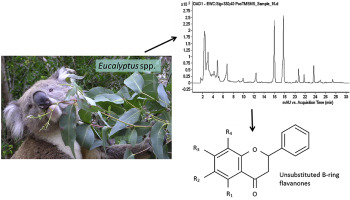当前位置:
X-MOL 学术
›
Phytochemistry
›
论文详情
Our official English website, www.x-mol.net, welcomes your feedback! (Note: you will need to create a separate account there.)
Occurrence and distribution of unsubstituted B-ring flavanones in Eucalyptus foliage
Phytochemistry ( IF 3.8 ) Pub Date : 2019-04-01 , DOI: 10.1016/j.phytochem.2019.01.005 Karen J. Marsh , Isha Saraf , Charles H. Hocart , Kara Youngentob , Inder-Pal Singh , William J. Foley
Phytochemistry ( IF 3.8 ) Pub Date : 2019-04-01 , DOI: 10.1016/j.phytochem.2019.01.005 Karen J. Marsh , Isha Saraf , Charles H. Hocart , Kara Youngentob , Inder-Pal Singh , William J. Foley

|
A group of plant specialised metabolites (PSMs) collectively known as unsubstituted B-ring flavanones (UBFs) have previously been found in the foliage of some species from the genus Eucalyptus L'Hér. (Myrtaceae), specifically from the subgenus Eucalyptus (monocalypts). Captive feeding studies using artificial diets suggest that these compounds may potentially influence the feeding preferences of marsupial folivores, such as koalas. Understanding natural variation in the composition and concentration of UBFs in eucalypt foliage is a first step to deciding whether, through their effects on herbivory, they might have broader effects on ecosystem dynamics. We used ESI-LCMS/MS and HPLC to characterise and quantify UBFs in 351 individual trees from 25 monocalypt species. We found large variation in the total UBF concentration both between and within species. For example, the mean concentration of UBFs in Eucalyptus muelleriana was 0.2 mg g-1 dry wt, whereas it was 105.7 mg g-1 dry wt, with a range of 78.2-141.3 mg g-1 dry wt, in Eucalyptus mediocris. Different eucalypt species contained different subsets of ten UBFs, and three species showed potential chemotypic variation between individuals within species. Our results suggest that UBFs naturally vary between monocalypt species and individuals at concentrations that could realistically be expected to affect the feeding dynamics of marsupial eucalypt folivores. UBFs could be measured relatively rapidly and cheaply in future studies using near-infrared reflectance (NIR) spectroscopy, as we were able to successfully predict the total UBF concentration of samples from their NIR spectra, with an r2 value of 0.98 and a standard error of prediction (SEP) of 6.07. This work further solidifies NIR spectroscopy as a powerful tool enabling ecologists to analyse the chemical composition of large numbers of samples.
中文翻译:

桉树叶中未取代B环黄烷酮的发生与分布
先前在 Eucalyptus L'Hér 属的某些物种的叶子中发现了一组统称为未取代 B 环黄烷酮 (UBF) 的植物特化代谢物 (PSM)。(桃金娘科),特别是来自桉属(monocalypts)。使用人工饮食的圈养喂养研究表明,这些化合物可能会影响有袋类食叶动物(如考拉)的摄食偏好。了解桉树叶中 UBF 组成和浓度的自然变化是决定它们是否通过它们对食草动物的影响对生态系统动态产生更广泛影响的第一步。我们使用 ESI-LCMS/MS 和 HPLC 来表征和量化来自 25 种单叶树种的 351 棵个体树木中的 UBF。我们发现物种之间和物种内的总 UBF 浓度变化很大。例如,在 Eucalyptus muelleriana 中 UBF 的平均浓度为 0.2 mg g-1 干重,而在 Eucalyptus mediocris 中为 105.7 mg g-1 干重,范围为 78.2-141.3 mg g-1 干重。不同的桉树物种包含 10 个 UBF 的不同子集,三个物种在物种内的个体之间显示出潜在的化学型变异。我们的研究结果表明,UBFs 在单加林物种和个体之间自然变化,其浓度实际上可能会影响有袋桉树食叶动物的摄食动态。在未来的研究中,可以使用近红外反射 (NIR) 光谱相对快速和廉价地测量 UBF,因为我们能够从其 NIR 光谱成功预测样品的总 UBF 浓度,r2 值为 0.98,预测标准误差 (SEP) 为 6.07。这项工作进一步巩固了 NIR 光谱作为一种强大的工具,使生态学家能够分析大量样品的化学成分。
更新日期:2019-04-01
中文翻译:

桉树叶中未取代B环黄烷酮的发生与分布
先前在 Eucalyptus L'Hér 属的某些物种的叶子中发现了一组统称为未取代 B 环黄烷酮 (UBF) 的植物特化代谢物 (PSM)。(桃金娘科),特别是来自桉属(monocalypts)。使用人工饮食的圈养喂养研究表明,这些化合物可能会影响有袋类食叶动物(如考拉)的摄食偏好。了解桉树叶中 UBF 组成和浓度的自然变化是决定它们是否通过它们对食草动物的影响对生态系统动态产生更广泛影响的第一步。我们使用 ESI-LCMS/MS 和 HPLC 来表征和量化来自 25 种单叶树种的 351 棵个体树木中的 UBF。我们发现物种之间和物种内的总 UBF 浓度变化很大。例如,在 Eucalyptus muelleriana 中 UBF 的平均浓度为 0.2 mg g-1 干重,而在 Eucalyptus mediocris 中为 105.7 mg g-1 干重,范围为 78.2-141.3 mg g-1 干重。不同的桉树物种包含 10 个 UBF 的不同子集,三个物种在物种内的个体之间显示出潜在的化学型变异。我们的研究结果表明,UBFs 在单加林物种和个体之间自然变化,其浓度实际上可能会影响有袋桉树食叶动物的摄食动态。在未来的研究中,可以使用近红外反射 (NIR) 光谱相对快速和廉价地测量 UBF,因为我们能够从其 NIR 光谱成功预测样品的总 UBF 浓度,r2 值为 0.98,预测标准误差 (SEP) 为 6.07。这项工作进一步巩固了 NIR 光谱作为一种强大的工具,使生态学家能够分析大量样品的化学成分。


























 京公网安备 11010802027423号
京公网安备 11010802027423号